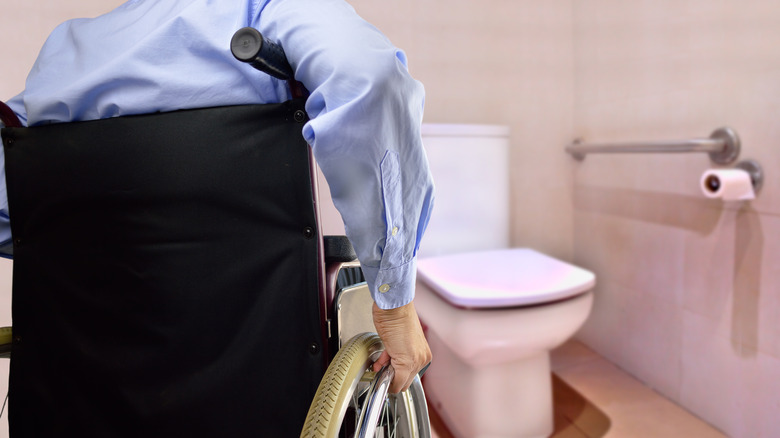Mike Holmes' Essential Advice For A Bathroom Renovation For Aging Residents
According to the latest data by S&P Global, one in five Americans is expected to become part of the elderly population (65 years and older) by 2030. Interestingly, many people approaching this age group fail to recognize how their homes should be better equipped for the bodily changes that will transpire as part of aging. A remodel may be necessary to accommodate such changes. For celebrity contractor Mike Holmes, the flooring should be an essential priority when renovating the different parts of the house, especially the bathroom, for aging residents.
"Being able to navigate your home could be a challenge as you age or are dealing with disabilities — the idea is to mitigate that as much as possible," Holmes says on his Make It Right blog, continuing, "Your accessibility needs should dictate what kind of materials you use in your home, especially when it comes to your flooring." He advises that selecting non-slip, durable surfaces that can withstand the wear and tear of the space due to wheelchairs, walkers, and other mobility aids is the best way to go. This is among the bathroom remodel features Mike Holmes thinks are worth installing.
Since some mobility devices, like wheelchairs, tend to be heavy, it's important to consider them when choosing the flooring material for a bathroom update. Softer materials will deteriorate quickly. Meanwhile, more durable options can withstand the weight and give the room the boost it needs to be fully functional for senior users.
What flooring material is the best for an aging resident's bathroom remodel?
Holmes does not have a specific material in mind for an aging resident's bathroom remodel. Instead, he has a few go-to options for this purpose. However, he has some caveats about each material. For instance, while hardwood is undeniably attractive, the celebrity builder says some types tend to be too soft and can be easily damaged. Luxury vinyl flooring (LVF) is a good alternative since it is water-resistant, cost-effective, and at times, more stylish than real wood. It also provides a good grip underfoot, making it an ideal choice for spaces frequented by aging residents.
Laminate and tile are also two of the best flooring options, according to HGTV stars such as Holmes. The former can mimic wood but with better durability and resistance to damage. Laminate also tends to be more affordable than hardwood. Holmes particularly recommends porcelain tiles for bathrooms because they are durable and easy to maintain, which is a plus for elderly homeowners with limited mobility. Plus, they are more resistant to stains and damage from water due to their lower absorption rate.
Another material Holmes suggests to homeowners is carpet. Though not as user-friendly for wheelchairs and walkers, carpets can serve the purpose when properly installed. Thinner variants tend to be less resistant so they can accommodate accessibility devices well. Thicker ones with padding can provide cushioning during falls and accidents. However, since they can trap moisture, they invite mold and mildew into the bathroom, which can be problematic for senior residents.
Holmes' other tip for renovating the bathroom for aging users
Future-proofing the bathroom means thinking beyond the present day's aesthetics and functionality for mobility challenges that could arise later on. While choosing the right flooring material can already make a big difference in the safety and use of a bathroom for aging residents, that's just one part of the solution. According to Holmes, the space should also be wide enough to accommodate wheelchair turns. Proper measurements or sizing of the bathroom is necessary for it to remain functional when its users reach a certain age that will require them to use mobility aids. Its layout should also enable users to move freely and use the bathroom without restrictions. An open layout is recommended so that even caregivers can fit in the space and provide care to the elderly residents when needed.
To apply Holmes' suggestions in your own bathroom, look for a flooring material that strikes a balance between form and function. If you love the look of wood or simply want to be consistent with the rest of the aesthetics of your bathroom, consider high-quality vinyl or laminate since they can handle the wear caused by regular use of mobility aids. However, if you want something more stylish but easy to clean with limited mobility, then go for porcelain tiles.


